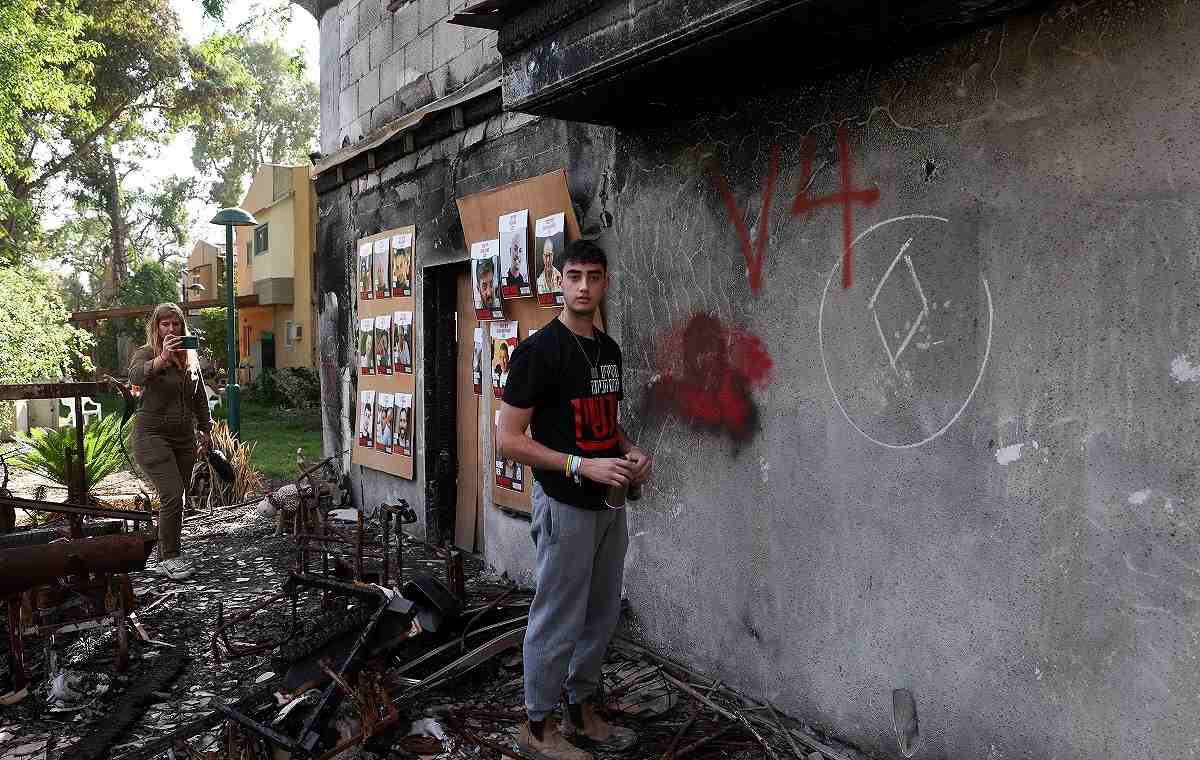
Israeli Ofir Engel, 18, who was taken hostage during the October 7 attack on Israel by Palestinian militant group Hamas and then released as part of a temporary ceasefire, visits Kibbutz Beeri to demand an immediate release of all remaining hostages, in Israel, December 20, 2023.
11:56 JST, December 22, 2023
CAIRO/GAZA/JERUSALEM, Dec 20 (Reuters) – The leader of Hamas visited Egypt for this first time in more than a month on Wednesday, a rare personal intervention in diplomacy amid what a source described as intensive talks on a new ceasefire to let aid reach Gaza and free more hostages.
Hamas leader Ismail Haniyeh, who normally resides in Qatar, typically wades publicly into diplomacy only when progress seems likely. He last traveled to Egypt in early November before the announcement of the only ceasefire in the Gaza war so far, a week-long pause that saw the release of about 110 of 240 hostages taken by Hamas in its Oct. 7 rampage into Israel.
Islamic Jihad, a smaller Palestinian militant group that is also holding hostages in Gaza, said its leader would also visit Egypt in coming days to discuss a possible end to the conflict.
A source briefed on negotiations said envoys were intensively discussing which of the hostages still held by Palestinian Islamist militants in Gaza could be freed in a new truce and what prisoners Israel might release in return.
Israel was insisting all remaining women and infirm men among hostages be released, the source said, declining to be identified. Palestinians convicted of serious offenses could be on the list of prisoners to be freed by Israel.
Later on Wednesday, U.S. President Joe Biden said he did not expect a second Israel-Hamas hostage release deal to be struck soon, though he added in remarks to reporters: “We’re pushing.”
A United Nations Security Council vote on a bid to boost aid to the Gaza Strip has again been delayed at the request of the U.S., diplomats said.
Nearly 20,000 deaths have been confirmed dead by the Gazan health ministry, with several thousand more bodies believed to be trapped under rubble. Israel says Hamas fighters killed 1,200 people, mainly civilians, on Oct. 7.
NETANYAHU DEFIANT ON CEASEFIRE CALLS
There remains a huge gulf between the two sides’ publicly stated positions on any halt to fighting. Hamas rejects any further temporary pause and says it will discuss only a permanent ceasefire. Israel has ruled that out and says it will agree only limited humanitarian pauses until Hamas is defeated.
“Hamas’ stance remains: they don’t have a desire for humanitarian pauses. Hamas wants a complete end to the Israeli war on Gaza,” a Palestinian official said.
Israeli Prime Minister Benjamin Netanyahu repeated that the war would end only with Hamas eradicated, all hostages freed and Gaza posing no more threat to Israel.
“Whoever thinks we will stop is detached from reality…All Hamas terrorists, from the first to the last, are dead men walking,” he said in a statement on Wednesday.
Israel has faced increasing pressure from its Western allies to curb a military onslaught in Gaza that has laid waste to much of the densely populated coastal enclave.
The U.S., Israel’s closest ally, has stepped up calls in the past week for it to scale down its all-out war into a focused campaign against Hamas leaders and end what Biden has called “indiscriminate bombing” causing huge civilian casualties.
In a serious spillover from the war, Yemen’s Houthi forces have been firing missiles and drones at commercial shipping in the Red Sea to underline support from Iran’s Arab militia proxies for the Palestinians against Israel, and the U.S. this week set up a multinational force to ward off the attacks.
On Wednesday, the Houthis’ leader warned they would strike U.S. warships if their forces were targeted by Washington.
INTENSIFYING WAR
Inside Gaza, Reuters saw wounded victims of Israeli bombing, including at least two small children covered in blood and dust, carried into the Nasser hospital in the southern city of Khan Younis. At the hospital morgue, women wearing black abaya robes wailed by bodies laid out in black bags and white shrouds.
At least 20 people were killed in Israeli air strikes on two houses in Khan Younis, the Palestinian Health Ministry in the West Bank said.
Since the last truce collapsed on Dec. 1, the war has entered a more intensive phase, with ground combat previously confined to the northern half of the Gaza Strip now spread across the length of the territory.
International aid groups say Gaza’s 2.3 million people have been driven to the brink of catastrophe by wholesale destruction that has driven 90% of them from their homes and left many malnourished and gravely short of clean water and medical care.
In the north, which Israeli forces claimed to have largely subdued last month, fighting has been fiercer than ever. Flames and smoke towered into the sky as seen from across the boundary fence in Israel, as Israeli warplanes pounded the area at dawn.
The Palestinian Red Crescent said Israeli forces had besieged its ambulance depot in Jabalia, a northern settlement that has been embattled for weeks. There are 127 people in the facility including workers, displaced people and wounded.
In the south, where most civilians are now sheltering after fleeing other areas, there has been intense fighting around the center of Khan Younis, which Israeli forces have partly stormed.
Hamas has waged guerrilla-style warfare based on a vast web of underground tunnels where it has hidden fighters, weaponry and, Israel says, political leaders and armed-wing commanders.
Hamas’ armed wing Al Qassam Brigades said on Wednesday its fighters killed 25 Israeli soldiers and injured dozens more over the prior 72 hours in Gaza. The Hamas fighters targeted Israeli troops at point-blank range and booby-trapped two tunnels and a house, an Al Qassam spokesperson said. Reuters could not independently verify the account.
On Wednesday, Israel’s military said soldiers had unearthed a network of tunnels, accessed by spiral staircases and an elevator, running deep beneath central Gaza City from properties registered to Yahya Sinwar and other senior Hamas figures. They had used the tunnels for “protected daily movement,” it said.
"News Services" POPULAR ARTICLE
-

American Playwright Jeremy O. Harris Arrested in Japan on Alleged Drug Smuggling
-

Taiwan President Shows Support for Japan in China Dispute with Sushi Lunch
-

Japan’s Nikkei Stock Average as JGB Yields, Yen Rise on Rate-Hike Bets
-

Japan’s Nikkei Stock Average Licks Wounds after Selloff Sparked by BOJ Hike Bets (UPDATE 1)
-

Japanese Bond Yields Zoom, Stocks Slide as Rate Hike Looms
JN ACCESS RANKING
-

Japan’s Hopes for Seafood Exports Shot Down in China Spat
-

Keidanren Chairman Yoshinobu Tsutsui Visits Kashiwazaki-Kariwa Nuclear Power Plant; Inspects New Emergency Safety System
-

Japan to Charge Foreigners More for Residence Permits, Looking to Align with Western Countries
-

Japan Exports Rise in October as Slump in U.S. Sales Eases
-

Govt Aims to Expand NISA Program Lineup, Abolish Age Restriction


























